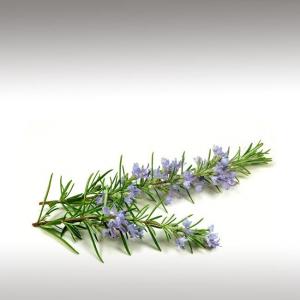
ROSEMARY VERBENONE ESSENTIAL OIL (ROSMARINUS OFFICINALIS CT. VERBENONE) - ESSENTIAL OILS

BASE / GENERAL DATA
Information submited: March 3, 2015 Modified: March 22, 2018 By: OperaDreamhouse
Botanical Name: Rosmarinus officinalis ct. verbenone
Common Method of Extraction: Steam Distilled
Part Typically Used: Leaves and flowers
Color: Clear/Pale yellow
Consistency: Thin
Perfumery Note: Middle
Strength of Initial Aroma: Fresh, herbaceous, sweet, slightly medicinal, strong, penetrating, fresh woody-herbaceous and somewhat minty-coniferous aroma.
There are three varieties of rosemary that you may see in aromatherapy:
Rosmarinus officinalis ct. cineole
Rosmarinus officinalis ct. verbenone
Rosmarinus officinalis ct. camphor
In the names there above, “ct.” stands for “Hemotype,” which simply means variety. Chemotypes, or varieties, in Rosemary occur because of conditions like inherent plant variety, light, soil, location, and temperature of where it is grown.
Rosmarinus Officinalis ct. Verbenone plant native to the Mediterranean region, growing wild in Spain, Portugal, southern France, Corsica, Italy, Sardinia, the former Yugoslavia, Russia, Turkey, the Middle East, and northern Africa. The essential oilis produced mainly in France, Spain, Morocco, and Tunisia.
Rosmarinus Officinalis ct Verbenone is a woody perennial evergreen and drought-resistant shrub that grows to a height 2 meters with thin dark green needle-shaped leaves and flowers that bloom from early summer through fall. The whole plant is highly aromatic. Rosemary essential oil is obtained from distillation of the fresh leaves and the flowering tops.
This popular herb has roots in mythology, medicine, culinary arts, magic, and literature that go back thousands of years. In ancient times, Greeks scholars wore strands of fresh Rosemary around their necks as they studied to improve memory and concentration.
In Greek mythology, Aphrodite was born from the sea. She rose up from the foaming waves adorned with garlands of Rosemary. Aphrodite is the Greek goddess of love, beauty, and pleasure. Rosemary has also been symbolic for remembrance and loyalty, and it has also been used in weddings and funerals in ages past.
It is a member of the mint family Lamiaceae, which also includes many other herbs. The name Rosemary derives from the Latin name Rosmarinus, which is from "Dew" (Ros) and "Sea" (Marinus), or "Dew of the sea", apparently because it is frequently found growing near the sea.
Regarding the difference in Rosemary essential oils, it is important to note that Rosemary ct Verbenone is milder (and has a milder aroma) than Rosemary ct cineol due to its lower camphor and higher verbenone content.
Rosmarinus Officinalis ct. Verbenone is with a strong, penetrating, fresh woody-herbaceous and somewhat minty-coniferous aroma; the dry out has a clean, long lasting, dry - herbaceous tone.
Common Method of Extraction: Steam Distilled
Part Typically Used: Leaves and flowers
Color: Clear/Pale yellow
Consistency: Thin
Perfumery Note: Middle
Strength of Initial Aroma: Fresh, herbaceous, sweet, slightly medicinal, strong, penetrating, fresh woody-herbaceous and somewhat minty-coniferous aroma.
There are three varieties of rosemary that you may see in aromatherapy:
Rosmarinus officinalis ct. cineole
Rosmarinus officinalis ct. verbenone
Rosmarinus officinalis ct. camphor
In the names there above, “ct.” stands for “Hemotype,” which simply means variety. Chemotypes, or varieties, in Rosemary occur because of conditions like inherent plant variety, light, soil, location, and temperature of where it is grown.
Rosmarinus Officinalis ct. Verbenone plant native to the Mediterranean region, growing wild in Spain, Portugal, southern France, Corsica, Italy, Sardinia, the former Yugoslavia, Russia, Turkey, the Middle East, and northern Africa. The essential oilis produced mainly in France, Spain, Morocco, and Tunisia.
Rosmarinus Officinalis ct Verbenone is a woody perennial evergreen and drought-resistant shrub that grows to a height 2 meters with thin dark green needle-shaped leaves and flowers that bloom from early summer through fall. The whole plant is highly aromatic. Rosemary essential oil is obtained from distillation of the fresh leaves and the flowering tops.
This popular herb has roots in mythology, medicine, culinary arts, magic, and literature that go back thousands of years. In ancient times, Greeks scholars wore strands of fresh Rosemary around their necks as they studied to improve memory and concentration.
In Greek mythology, Aphrodite was born from the sea. She rose up from the foaming waves adorned with garlands of Rosemary. Aphrodite is the Greek goddess of love, beauty, and pleasure. Rosemary has also been symbolic for remembrance and loyalty, and it has also been used in weddings and funerals in ages past.
It is a member of the mint family Lamiaceae, which also includes many other herbs. The name Rosemary derives from the Latin name Rosmarinus, which is from "Dew" (Ros) and "Sea" (Marinus), or "Dew of the sea", apparently because it is frequently found growing near the sea.
Regarding the difference in Rosemary essential oils, it is important to note that Rosemary ct Verbenone is milder (and has a milder aroma) than Rosemary ct cineol due to its lower camphor and higher verbenone content.
Rosmarinus Officinalis ct. Verbenone is with a strong, penetrating, fresh woody-herbaceous and somewhat minty-coniferous aroma; the dry out has a clean, long lasting, dry - herbaceous tone.

SPIRITUAL PRACTISES DATA

MEDICINE / HEALTH DATA

BEAUTY / COSMETICS DATA

FOOD / COOKING DATA
COMMENTS
No comments.
Newest mixtures containing Rosemary Verbenone Essential Oil (Rosmarinus Officinalis ct. Verbenone):

Essential Oil for the Fifth Chakra (The Throat Chakra - Vishuddha)
March 3, 2015


